|
Pivotal World Series Moments
Huggins Stays with Shawkey; Ruth Injured
1921 World Series Game 3: New York Yankees@New York Giants
For three seasons starting in 1919, Babe Ruth revolutionized the game of baseball with feats never thought possible. In his last year with the Red Sox, he led the American League in runs scored (103), home runs (29), and RBI (113). With the Yankees the next year, he again led the league in runs (158), home runs (54), and RBI (135) as well as walks (150). 1921 brought more of the same. He crossed the plate 177 times, broke his own home run again with 59, and drove in 168 runs while walking 145 times to lead the Yankees to their first pennant.
Ruth drove in a run in the Yanks' Game 1 3-0 victory over the Giants. He walked three times and scored a run in Game 2 in another 3-0 triumph.
The crudity of the sport in those days is illustrated by this sentence from 1921: The Yankees, the Giants, and the Battle for Baseball Supremacy in New York: "The teams exchanged taunts throughout the afternoon, hurling vulgarities and obscenities at each other regarding ethnicity, physical characteristics, family members, and anything else they felt might upset their opponents. At one point, home plate umpire George Moriarty threatened to clear the Yankees' bench if the players did not stop."
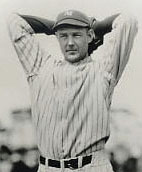 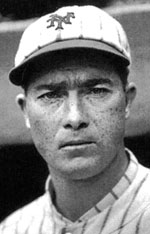  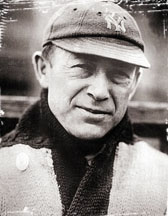 L-R: Bob Shawkey, Jesse Barnes, Dave Bancroft, Miller Huggins The Yankees broke the scoreless tie with four runs in the top of the third. Two of the tallies scored on Ruth's sizzling bases-loaded single to center.
Down two games to none and trailing 4-0, the Giants fought back with four runs of their own against Bob Shawkey in the bottom of the third. P Jesse Barnes, who relieved Fred Toney in the top of the inning, started the uprising with a single. After a fly out, SS Dave Bancroft singled Barnes to second. At that point, Yanks manager Miller Huggins signaled for Jack Quinn to warm up in the bullpen.
When Shawkey fell behind 2B Frankie Frisch and walked him, Yankee fans began yelling for Huggins to bring in Quinn. But he didn't, and RF Ross Youngs walked to force in a run. When Shawkey then became the first pitcher in World Series history to walk three batters in a row, forcing in another run, Huggins finally made the move.
The Giants finished the inning with four runs of their own to tie the score. It remained deadlocked until they exploded for eight runs in the seventh off relievers Rip Collins and Tom Rogers on their way to the 13-5 victory.
 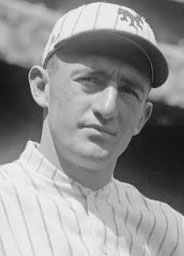 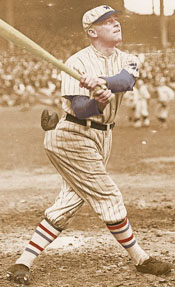 L-R: Jack Quinn, Frankie Frisch, Ross Youngs The Yankees had surprised the Giants with their aggressiveness on the base paths during the Series. A Yankee stole home in each of the first two games - 3B Mike McNally in Game 1 and Bob Meusel in Game 2. In addition, McNally also stole second, and Wally Pipp swiped second in Game 1. The next day, the speedy Ruth stole both second and third base, and McNally was caught stealing second.
While sliding into third on his second steal in Game 2, Ruth tore up his left elbow on the pebbly basepath. He said in his 1948 autobiography that he "developed an access on my left elbow a few days before the Series." Then he aggravated the injury stealing the same base in Game 3 to the point where the Yankees announced that he would not play in Game 4.
"The Yankees have lost not only his great hitting," wrote The New York Times, "but also the smartness and cunning that this ball player brings to the team." The article claimed that Ruth "conceived and directed most of the daring base running to the credit of the Yankees, and his value as a strategist has excelled even his ability to punch the ball to distant regions."
Babe insisted on playing in Game 4 and smacked a home run and a single. But the Giants evened the Series with a 4-2 victory.
Game 5 would break the tie in games. While the elbow got the publicity, Babe's knee was going lame. Nevertheless, he took his post in left field and the third spot in the batting order. With his elbow on fire, he struck out three times but still helped the team by scoring the go-ahead run in the fourth after starting the inning with a bunt single.
But the Yankees, concerned about the spreading infection in his arm and his gimpy knee, kept him on the bench the rest of the Series. Huggins said after Game 5, "How he had been able to do what he had done during the afternoon made me look at him in amazement. It was an exhibition of gameness that will go down through baseball history." Sportswriter Grantland Rice wrote that Babe's swollen arm "looked like an elephant's thigh."
Babe contribution to the remaining three games consisted of a pinch-hitting appearance in Game 8.
References:
The Babe Ruth Story, Babe Ruth as told to Bob Considine (1948) 1921: The Yankees, the Giants, and the Battle for Baseball Supremacy in New York, Lyle Spatz and Steve Steinberg (2010) "Winning by Losing: Babe Ruth at the 1921 World Series," David Stewart, davidostewart.com, October 14, 2016 |